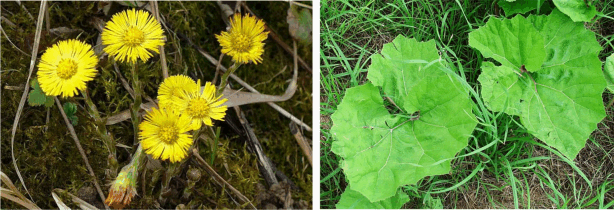
“It grows in pleasant moist places and near rivers which make a noise.” – William Salmon, 1693.
Tussilago farfara – what a wonderful name for a flower which is more commonly known as the Coltsfoot or locally as Bulls Foot, Coughwort, Sun Before Father or Boy’s Bacca. Coltsfoot can be found growing on Dartmoor virtually anywhere on and around the moorland fringes such as woodland margins, ditches, riverbanks, or cultivated land. In a way it could be described as a back to front plant because it first produces its flowers between February and April and then as these die off large heart-shaped basal leaves appear – hence the name ‘Son Before Father’. It is the shape of these leaves that can be attributed to its other names Coltsfoot and Bulls Foot as they do have somewhat of a hoof-like appearance. The large, yellow flower heads do look similar to a daisy in one way but also a dandelion in another. Pollination of the plant can be from either from insects or it has the capability to self-pollinate. The seeds of the Coltsfoot appear in the outer florets of the flower head and ripen between April and June when they then dispersed by the wind. It has been calculated that a single plant is capable of producing anything from 1,500 to 3,500 seeds which depending on the strength of the wind and height of the plant can travel anything up to four kilometres. The flowers are insect or self-pollinated. Seeds arise in the outer ray florets of the flower heads, rarely in the inner disk florets. The mean number of seeds per flower head is 157. Seed number per plant is around 1,500 to 3,500. By April-June the seeds are ripe and dispersal takes place. Due to the Coltsfoot’s ability to rapidly establish itself it has been regarded as an invasive weed which can prove to be problematic especially in gardens.

It has been said that the downy seeds of the Coltsfoot can be a good weather indicator for an early saying stated that; “if the down flyeth of Coltsfoot when there is no winde, it is a sign of rain.” It was also known that the downy seeds were sometimes used to stuff pillows and mattresses although you would have to collect one heck of a lot. Coltsfood down is often collected by small birds such as Goldfinches with which they line their nests.
But it is for the plant’s medicinal properties that it is most famous Culpeper contended that:
“The fresh leaves, or juice, or a syrup thereof, is good for a hot, dry cough, or wheezing, and shortness of breath. The dry leaves are best for those who have thin rheums and distillations upon their lungs, causing a cough ; for which also the dried leaves taken as tobacco, or the root, is very good. The distilled water hereof simply, or with elderflowers and night-shade, is a good remedy for hot agues, to drink two ounces at a time, and apply cloths wet therein to the head and stomach, which also does much good being applied to any hot swellings or inflammations. It helpeth St. Anthony’s fire, and burnings, and is good to take away wheals and pushes that arise through heat; as also the burning heat of the piles, or privy parts, cloths wet therein being thereunto applied. – Nicholas Culpeper, The Britsh Herbal, p. 93.
This is a good indicator as to the Coltsfoot’s names of Coughwort and Boy’s Bacca, In 1697 the herbalist John Gerard wrote; “A deconcoction of the greene leaves and roots, or else a syrup thereof, is good for the cough that proceedeth froma thin rheume… The fume of the dried leaves taken through a funnell or tunnell, burned upon oles, effectually those that are troubled with shortness of breath.. Being taken in a manner as they take tobacco, it mightily prevaileth against the disease aforesaid.” In other words for treatment against coughs and respiratory problems Coltsfoot can either be made into a infusion or smoked. Indeed, during the Second World War the dried leaves would be ground down into a tobacco and smoked purely as a cheap and readily available alternative to proper tobacco. Even today dried Coltsfoot is easily obtainable at around £4.50 for a 50g packet and some folk have smoked this as an aid to giving up smoking cigarettes. The other method of taking Coltsfoot was as a lozenge and today Stockleys Sweets produce a Coltsfoot Rock which a 1.3 kilogram jar sells for £12.49. One writer even recommended that when mixed with lard and burned in a new earthenware pot the salve when applied to a dog’s paw will draw out any thorns or splinters.
 Legendary Dartmoor The many aspects past and present of Dartmoor
Legendary Dartmoor The many aspects past and present of Dartmoor
